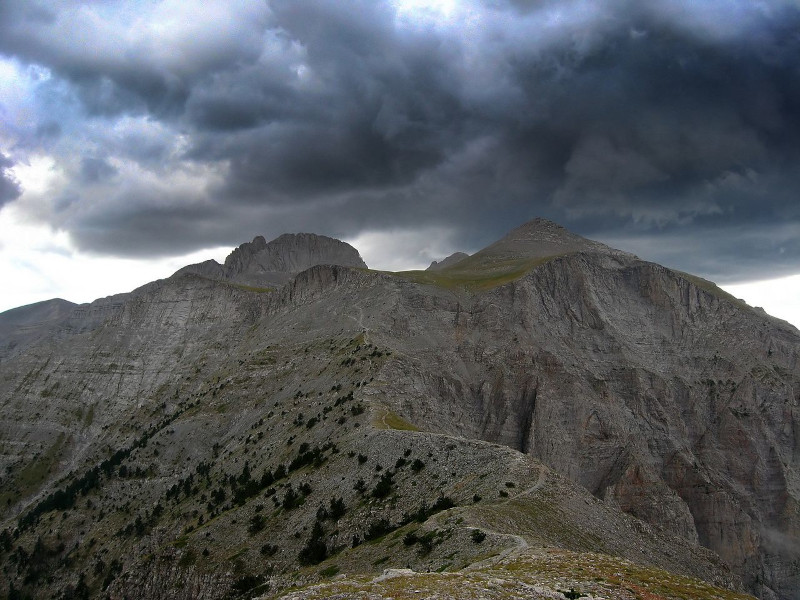
Mount Olympus Facts
- This majestic creation of time and natural geological forces most frequently goes by the english language name of Mount Olympus. Yet, it previously held at least one other title in the past. Though no long used, it once held the tag of Mount Belus.
- Not surprisingly, the natural marvel additionally holds yet another moniker. That’s the name given to it in the native language of the region in which it sits. In that tongue, the impressive construction of Nature holds the designation of Όλυμπος.
- It’s unknown when prehistoric humans first encountered the mountain itself. Archaeological evidence does indicate, however, that humans first entered its general area approximately 210,000 years ago. It’s thus likely they soon learned of its existence.
- The breathtaking Mount Olympus holds a special place in the culture of its region. It also holds an amazing array of life. Due to these factors, it became a National Park in 1938. The site was also later named as an important World Biosphere Reserve.
- These statuses serve to provide the site with a certain degree of protection from the depredations of man. Authorities take great care to maintain its natural state. Its sheer popularity with tourists, though, creates difficulties with preserving that condition.
Related Articles
Mount Olympus Physical Description
The magnificent Mount Olympus understandably catches the eye and attention of all those fortunate enough to visit the site. Yet, this wonder of Nature doesn’t simply do so for a single reason. That’s true since it holds numerous attributes to appeal to the viewer.
Incredibly, it isn’t just a single peak. Instead, the mountain presents an astounding total of 52 peaks to those who look closely. These vary in height, of course. The tallest of them, however, bears the name of Mytikas. This peak stands an impressive 9,573 ft (2,918 m).
Another feature it holds, though, contrasts these in an almost unbelievable manner. That’s due to the fact that the mountain also plays host to numerous deep gorges. Some of these features have mild slopes, while the walls of others have steeply inclined slopes.
But these aren’t the only geological qualities of this location that garner attention, however. The sheer scale of the mesmerizing site also generally impresses the visitor. It’s not only massive, but it also ranks as one of the highest peaks on the continent it sits on.
At its broad base, the beautiful Mount Olympus has a circumference totaling approximately 50 mi (80 km)! An average diameter equals 16 mi (26 km). Perhaps even more astonishing is its total area, though. Amazingly, this measures a remarkable 190 sq mi (500 sq km).
Mount Olympus Location, Formation, and Ecology
The unforgettable and culturally important Mount Olympus formed in a region of the world already well known for its abundance of similar wonders. That’s due to the fact that Nature created the true masterpiece of geography and geology on the continent of Europe.
Within the borders of the continent, the mountain sits in the national borders of the country of Greece. It’s placement further puts it about 50 mi (80 km) southwest of Thessaloniki. It’s also roughly on the border between the regions of Macedonia and Thessaly.
The origins of this creation of Nature reaches back to roughly 200 million years ago. At that time, sediment was deposited in a shallow sea present at the time. The ensuing ages saw countless more layers added, with the resulting pressures creating the hardened stone.
The slow yet inexorable process of uplift eventually pushed it upward. Then around 1 million years ago, large glaciers covered the region, with their movements carving out its many depressions and plateaus. Later melting formed even more of its features, however.
Overall, the stunning Mount Olympus has a Mediterranean climate. This therefore allows for the support of a thriving ecosystem. In fact, it boasts one of the greatest concentrations of flora in the entire country it sits in. Roughly 1,700 plant species and subspecies appear here.
This includes a surprisingly large number of tree varieties, including the Strawberry Tree and the Bosnian Pine. Alpine meadows also harbor a wide array of different species of grasses and wildflowers. Of these, in fact, 23 of them appear nowhere else in the entire world.
Animals live here in numbers, too, though larger one’s no longer do so. This includes various mammals, such as squirrels and foxes. A total of 108 species of birds also call the mountain home. Numerous smaller reptiles and amphibians share the same habitat, as well.
Features Sharing Its Region
Check out our other articles on 7 Magnificent West Coast Marvels, Giant Grizzled Squirrel, McMurdo Dry Valleys, Great Rhododendron, Mountain Apollo, Fire Salamander, Green Iguana
